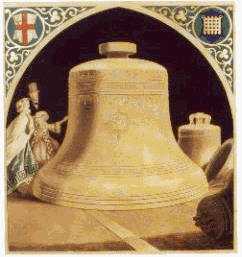 urch
bells, so I thought that I would give that a try.
urch
bells, so I thought that I would give that a try.PULL THE OTHER ONE
"I’m fed up of you mooching around the house with nothing to do," said mother to her bored 13-year-old son. "Get out and get yourself a hobby." Little did either of them know what a life-changing effect those words were to have on that young boy.
I knew that a couple of school friends were into some
strange pastime called ‘campanology’ which had something to do with ringing ch urch
bells, so I thought that I would give that a try.
urch
bells, so I thought that I would give that a try.
Some 40 years later I am still ringing bells, having rung at towers the length and breadth of the country, including many of the great cathedrals such as York Minster and Durham and been privileged to ring with the monks at Buckfast Abbey. I have been on ringing holidays, made hundreds of friends of all ages, and even met my wife-to-be in a bell tower! So what is it about this strange pastime that holds such a fascination for thousands of bell-ringers throughout the land?
Bell ringing as a call to worship has been used in England since the eighth century. At that time bells dominated the life of individuals and communities. They were the sound-clocks of the day, signaling that the day’s work was done, along with other secular uses such as the opening and closing of markets, summoning people to meetings and marking occasions of rejoicing or remembrance.
In the late 16th century bell-ringing became a popular with the gentry and this was probably why, at that time, many rings of bells were restored and augmented, in some instances encouraged by a spot of one-upmanship between neighbouring parishes. Early bell ringing consisted of a discordant jingle-jangle of noise with the bells being rung haphazardly, but gradually the English began to ring them in a more orderly fashion.
However, it was not until the early 17th century that the art took a massive leap forward. Technological advances enabled the bell to be rung in a complete circle, giving control over the timing of the sound by the ringer being able to pause with the bell perfectly balanced in the mouth-up position. This led to the ability of changing the order in which the bells were rung with each pull of the rope. Cambridge University students developed methods of changing the order in set sequences without repetition and thus Change Ringing was born (from which we get the expression ringing the changes).
 The new science
spread rapidly throughout the land and the country became known as ‘The
Ringing Isle’. The methods of ringing different sequences were given weird
and wonderful names such as Grandsire Doubles and Reverse Canterbury Pleasure.
Societies were formed and meetings organised to bring ringers together to
practice and develop their skills. It was a considerable achievement, both
physically and mentally, to ring all possible sequences on seven bells (5040 of
them) and to ring 5000 or more became known as a ‘peal’. This would take about
three hours to complete and is still considered a major milestone in a ringer’s
development.
The new science
spread rapidly throughout the land and the country became known as ‘The
Ringing Isle’. The methods of ringing different sequences were given weird
and wonderful names such as Grandsire Doubles and Reverse Canterbury Pleasure.
Societies were formed and meetings organised to bring ringers together to
practice and develop their skills. It was a considerable achievement, both
physically and mentally, to ring all possible sequences on seven bells (5040 of
them) and to ring 5000 or more became known as a ‘peal’. This would take about
three hours to complete and is still considered a major milestone in a ringer’s
development.
Whilst providing a service to the Church, bell ringing today is a most absorbing hobby with a unique camaraderie amongst its members. It is suitable for anyone aged twelve and over who is reasonably fit. If anyone would like to have a go, or maybe just like to see a team in action, then they would be very welcome to come along to St. John’s, Broughton on a Monday evening – please call me on 713942 to arrange a suitable time.
Roy Jolley
www.cccbr.org.uk/ (The Central Council of Church Bellringers)
www.hrgb.org.uk (Handbell ringers of Great Britain)